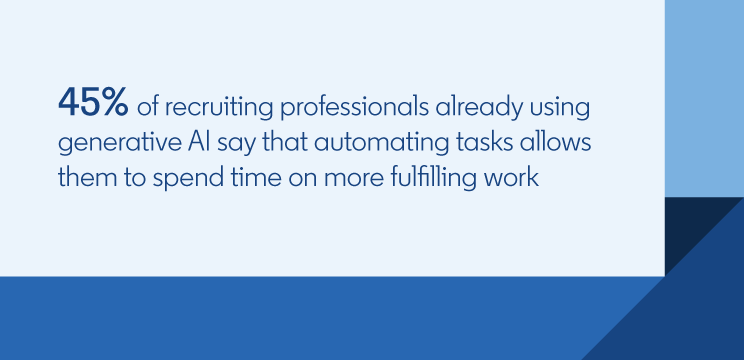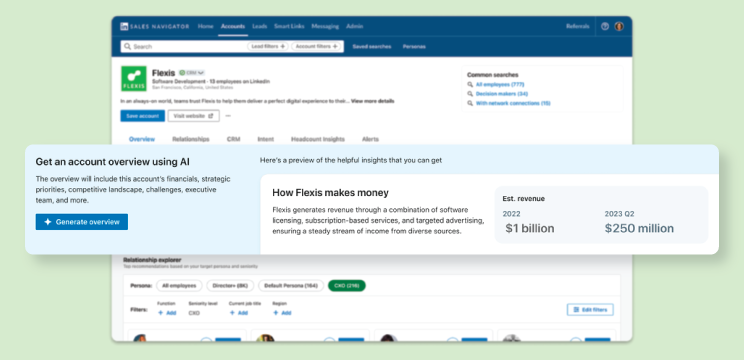
How AI for Nonprofits Is Changing the Industry for Good
Generative AI is in the process of transforming the world of work, including the nonprofit industry. But given how fast this shift is occurring and the sheer amount of information circulating about it, it’s understandable that many nonprofit professionals are approaching AI with both interest and caution.
If you’re curious about how AI for nonprofits might help your team but you need to know more before you jump in, you’re not alone. Taking the time to understand generative AI and what it means for you and your nonprofit is the best way to make the most of this new technology.
These four use cases from the nonprofit industry are a good place to start. Explore how AI for nonprofits is already starting to change how nonprofit professionals like you approach their work — and how you and your team can start incorporating it into your processes right now.
1. Automating busy work
As Naria Santa Lucia, General Manager of Digital Inclusion and Community Engagement for Microsoft Philanthropies, explains in the Moving Forward newsletter, “Generative AI can help nonprofits improve their efficiency by automating tasks so that employees can spend more time focused on the mission.”
By speeding up busywork, generative AI may empower employees to spend more time on the strategic, creative, or collaborative work that they enjoy the most. For example, according to The Future of Recruiting 2024 report from LinkedIn, 45% of recruiting professionals who are already using generative AI report that a top benefit is the ability to automate some tasks, allowing them to spend time on more fulfilling work.

“Most of us will probably stay in the same roles, but how those jobs are performed will change dramatically,” Dr. Tomas Chamorro-Premuzic, Chief Innovation Officer at ManpowerGroup, explained in the session “Power a dynamic workforce by embracing AI” at LinkedIn Talent Connect 2023. “You may have to rethink how to do your tasks and reimagine your potential.”
2. Making hiring easier and faster
Hiring is a challenge for many nonprofits right now. In FORVIS’ 2024 State of the Nonprofit Sector Report, nearly three out of four (74%) of the 325+ nonprofits surveyed reported they had vacant positions they were struggling to fill.
Generative AI is already emerging as a possible part of the solution. Among the recruiting professionals already using generative AI surveyed by The Future of Recruiting report, 57% said that AI was making it faster and easier to write job descriptions, with 35% saying it’s faster and easier to engage with candidates, too.
Within the nonprofit sector, many talent professionals that use LinkedIn Recruiter are already experimenting with the new AI-assisted messaging feature to draft personalized InMails to high-potential candidates in a fraction of the time it would take otherwise. They can then rapidly review the message for accuracy and add a personal touch before hitting send.
This feature is already proving useful to talent professionals across industries. When LinkedIn began rolling out AI-assisted messaging in May 2023, 74% of recruiters said it saved them time.
3. Empowering more strategic fundraising
It’s not just talent professionals who can benefit from AI’s ability to support outreach efforts. Fundraising and development professionals can also leverage AI to surface relevant insights about prospective donors before reaching out.
For example, LinkedIn Sales Navigator’s new Account IQ feature leverages generative AI and real-time data on LinkedIn to provide an easy-to-read overview of a target company in seconds. The account overview includes information like revenue estimates, strategic priorities, business challenges, and related news about the organization.

AI-assisted tools like Account IQ can ensure fundraising and development professionals are equipped with the information they need to make a strong pitch or have a successful meeting — without needing to spend hours on tedious research first.
And since AI can help them gather this information quickly, they’ll have more time freed up to focus on the most human-centric aspects of fundraising, like relationship-building.
4. Supporting an agile nonprofit workforce
The skills required for jobs are evolving fast. Generative AI is only accelerating this evolution, with job skills predicted to change by up to 65% by 2030.
The rapid pace of change may require organizations to embrace agility and nurture a culture of continuous learning. AI can help — making it quicker and easier for employees to access the learning resources they need at the moment they need them.
For instance, some LinkedIn Learning users already have access to an AI-powered coaching feature that allows them to ask questions about skills they want to learn or improve. The chatbot then rapidly offers personalized advice and course recommendations that can help.
Even if you don’t use LinkedIn Learning at your organization right now, you can spark your team’s curiosity for learning and help them get started with AI by recommending the“Career Essentials in Generative AI” learning path from Microsoft and LinkedIn, available for free through 2025.
The changes AI for nonprofits is beginning to bring about are not necessarily going to rock the foundations of what you and your team do. Instead, they can help make your work easier, faster, and more efficient — so you can spend more time focused on moving your mission forward.
Learn more about how your nonprofits can leverage AI-assisted LinkedIn solutions to hire, fundraise, and develop its workforce today.

